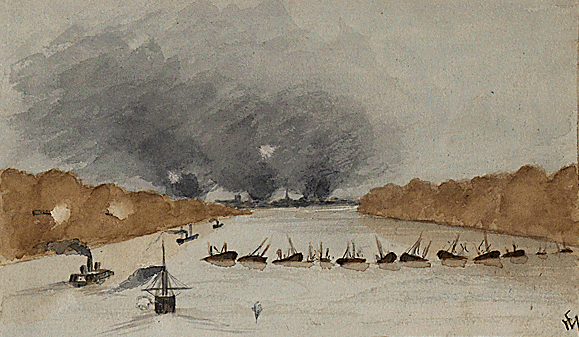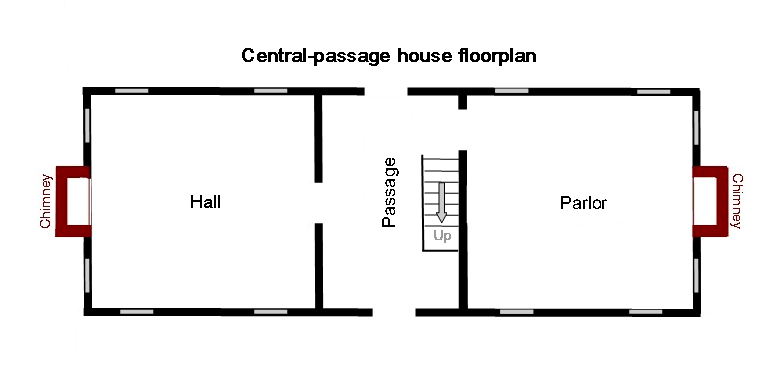|
John Wright Stanly House
The John Wright Stanly House is a historic home located at New Bern, Craven County, North Carolina. It was probably designed by John Hawks and built about 1779. It is a two-story, five bay, central hall plan Georgian style frame dwelling. It has a hipped roof and roof deck with balustrade. The building housed a public library from 1935 to 1965. It has been moved twice, coming to its present location in 1965, and subsequently restored as part of the Tryon Palace complex. The house's namesake is former owner John Wright Stanly, a Revolutionary War veteran. It was listed on the National Register of Historic Places The National Register of Historic Places (NRHP) is the United States federal government's official list of districts, sites, buildings, structures and objects deemed worthy of preservation for their historical significance or "great artistic v ... in 1970. References External links * Georgian architecture in North Carolina Historic American Buildings S ... [...More Info...] [...Related Items...] OR: [Wikipedia] [Google] [Baidu] |
New Bern, North Carolina
New Bern, formerly called Newbern, is a city in Craven County, North Carolina, United States. As of the 2010 census it had a population of 29,524, which had risen to an estimated 29,994 as of 2019. It is the county seat of Craven County and the principal city of the New Bern Metropolitan Statistical Area. It is located at the confluence of the Neuse and the Trent rivers, near the North Carolina coast. It lies east of Raleigh, north of Wilmington, and south of Norfolk. New Bern is the birthplace of Pepsi. New Bern was founded in October 1710 by the Palatines and Swiss under the leadership of Christoph von Graffenried. The new colonists named their settlement after Bern, the Swiss region from which many of the colonists and their patron had emigrated. The flag and arms of the American city are virtually identical to those of the Swiss canton. The English connection with Switzerland had been established by some Marian exiles who sought refuge in Protestant parts of Switze ... [...More Info...] [...Related Items...] OR: [Wikipedia] [Google] [Baidu] |
John Hawks (architect)
John Hawks ( – February 16, 1790) was a British-born American architect remembered as the dominant force in North Carolinian architecture for two decades, and a major designer of some of New Bern's most notable structures. He also served as the first auditor of North Carolina from 1784 until his death. Biography Hawks was born in England, c. 1731. He died at New Bern, North Carolina, on February 16, 1790. Buildings Several of Hawks's buildings are listed on the U.S. National Register of Historic Places (NRHP). * Coor House, built 1767, 501 E. Front St., New Bern, North Carolina, NRHP-listed * Governor's Palace, built 1770, 501 E. Front St., New Bern, North Carolina * Stanly House, built ca. 1779, 307 George St., New Bern, North Carolina, NRHP-listed * One or more works in Edenton Historic District, roughly bounded by E. & W. Freemason, S. Oakum, E. & W. Water, and Mosely Sts. Edenton, North Carolina, NRHP-listed See also * List of people with gout References E ... [...More Info...] [...Related Items...] OR: [Wikipedia] [Google] [Baidu] |
Georgian Architecture
Georgian architecture is the name given in most English-speaking countries to the set of architectural styles current between 1714 and 1830. It is named after the first four British monarchs of the House of Hanover—George I, George II, George III, and George IV—who reigned in continuous succession from August 1714 to June 1830. The so-called great Georgian cities of the British Isles were Edinburgh, Bath, pre-independence Dublin, and London, and to a lesser extent York and Bristol. The style was revived in the late 19th century in the United States as Colonial Revival architecture and in the early 20th century in Great Britain as Neo-Georgian architecture; in both it is also called Georgian Revival architecture. In the United States the term "Georgian" is generally used to describe all buildings from the period, regardless of style; in Britain it is generally restricted to buildings that are "architectural in intention", and have stylistic characteristics that are typical o ... [...More Info...] [...Related Items...] OR: [Wikipedia] [Google] [Baidu] |
Craven County, North Carolina
Craven County is located in the U.S. state of North Carolina. As of the 2020 census, the population was 100,720. Its county seat is New Bern. The county was created in 1705 as Archdale Precinct from the now-extinct Bath County. It was renamed Craven Precinct in 1712 and gained county status in 1739. It is named for William, Earl of Craven, who lived from 1606 to 1697. Craven County is part of the New Bern, NC, Metropolitan Statistical Area. History On August 4, 1661, George Durant purchased land from Cisketando, king of the Yeopim Indian tribe. On March 13, 1662, a second purchase was made from Kilcocanen, another Yeopim. By 1662 Durant was living in Virginia on a tract of land along the Perquimans River which flows into Albemarle Sound, which became part of the Carolina colony in 1665. Craven County was established in 1712 as Craven Precinct, a precinct of Bath County. It was named after William, Lord Craven, one of the Lords Proprietors. That year Christopher Gale becam ... [...More Info...] [...Related Items...] OR: [Wikipedia] [Google] [Baidu] |
Central-passage House
The central-passage house, also known variously as central hall plan house, center-hall house, hall-passage-parlor house, Williamsburg cottage, and Tidewater-type cottage, was a vernacular, or folk form, house type from the colonial period onward into the 19th century in the United States. It evolved primarily in colonial Maryland and Virginia from the hall and parlor house, beginning to appear in greater numbers by about 1700. It partially developed as greater economic security and developing social conventions transformed the reality of the American landscape, but it was also heavily influenced by its formal architectural relatives, the Palladian and Georgian styles with their emphasis on symmetry. Architectural features The central-passage house was built much like the earlier hall and parlor house, except that its hall and parlor were divided by a central passageway. In fact, in many of the earliest examples a hall-parlor arrangement had a second partition added inside th ... [...More Info...] [...Related Items...] OR: [Wikipedia] [Google] [Baidu] |
Baluster
A baluster is an upright support, often a vertical moulded shaft, square, or lathe-turned form found in stairways, parapets, and other architectural features. In furniture construction it is known as a spindle. Common materials used in its construction are wood, stone, and less frequently metal and ceramic. A group of balusters supporting a handrail, coping, or ornamental detail are known as a balustrade. The term baluster shaft is used to describe forms such as a candlestick, upright furniture support, and the stem of a brass chandelier. The term banister (also bannister) refers to a baluster or to the system of balusters and handrail of a stairway. It may be used to include its supporting structures, such as a supporting newel post. Etymology According to the ''Oxford English Dictionary'', "baluster" is derived through the french: balustre, from it, balaustro, from ''balaustra'', "pomegranate flower" rom a resemblance to the swelling form of the half-open flower (''illust ... [...More Info...] [...Related Items...] OR: [Wikipedia] [Google] [Baidu] |
Library
A library is a collection of materials, books or media that are accessible for use and not just for display purposes. A library provides physical (hard copies) or digital access (soft copies) materials, and may be a physical location or a virtual space, or both. A library's collection can include printed materials and other physical resources in many formats such as DVD, CD and cassette as well as access to information, music or other content held on bibliographic databases. A library, which may vary widely in size, may be organized for use and maintained by a public body such as a government; an institution such as a school or museum; a corporation; or a private individual. In addition to providing materials, libraries also provide the services of librarians who are trained and experts at finding, selecting, circulating and organizing information and at interpreting information needs, navigating and analyzing very large amounts of information with a variety of resources. Li ... [...More Info...] [...Related Items...] OR: [Wikipedia] [Google] [Baidu] |
Tryon Palace
Tryon Palace, formerly called Governor's Palace, Newbern, was the official residence and administrative headquarters of the British governors of North Carolina from 1770 to 1775. Located in New Bern, North Carolina, the palace was often at the center of state occasions and hospitality. The residence was seized by patriot troops in 1775. Shortly after the state capital was relocated to Raleigh in 1792, the main building burned to the ground. A modern recreation faithful to the original architect's plans and some period appropriate support structures were erected on the site in the 1950s and opened to the public in 1959. The palace garden was also recreated, with of plantings, representing three centuries of landscape and gardening heritage. Today, the palace is a state historic site. History Early history William Tryon was a British officer and colonial official who served as the Governor of North-Carolina from 1765 to 1771. Tryon had seen the need for a centrally-located Gove ... [...More Info...] [...Related Items...] OR: [Wikipedia] [Google] [Baidu] |
Biennial Report Of The North Carolina Historical Commission, Page 79 (1970) (6126465801)
Biennial means (an event) lasting for two years or occurring every two years. The related term biennium is used in reference to a period of two years. In particular, it can refer to: * Biennial plant, a plant which blooms in its second year and then dies * Biennale, the Italian word for "biennial" and a term used within the art world to describe an international exhibition of contemporary art, stemming from the use of the phrase for the Venice Biennale. (The English form, "biennial", is also commonly used to describe these art events.) See also * Biannual, meaning twice a year * Biennial bearing Biennial bearing (or alternate) bearing is a term used in pomology to refer to trees that have an irregular crop load from year to year. In the "on" year too much fruit is set, leading to small fruit size. Excess weight in the main branches can be ... trees, which produce fruit once every two years {{disambiguation Units of time ... [...More Info...] [...Related Items...] OR: [Wikipedia] [Google] [Baidu] |
National Register Of Historic Places
The National Register of Historic Places (NRHP) is the United States federal government's official list of districts, sites, buildings, structures and objects deemed worthy of preservation for their historical significance or "great artistic value". A property listed in the National Register, or located within a National Register Historic District, may qualify for tax incentives derived from the total value of expenses incurred in preserving the property. The passage of the National Historic Preservation Act (NHPA) in 1966 established the National Register and the process for adding properties to it. Of the more than one and a half million properties on the National Register, 95,000 are listed individually. The remainder are contributing resources within historic districts. For most of its history, the National Register has been administered by the National Park Service (NPS), an agency within the U.S. Department of the Interior. Its goals are to help property owners and inte ... [...More Info...] [...Related Items...] OR: [Wikipedia] [Google] [Baidu] |
Georgian Architecture In North Carolina
Georgian may refer to: Common meanings * Anything related to, or originating from Georgia (country) **Georgians, an indigenous Caucasian ethnic group **Georgian language, a Kartvelian language spoken by Georgians **Georgian scripts, three scripts used to write the language **Georgian (Unicode block), a Unicode block containing the Mkhedruli and Asomtavruli scripts **Georgian cuisine, cooking styles and dishes with origins in the nation of Georgia and prepared by Georgian people around the world * Someone from Georgia (U.S. state) * Georgian era, a period of British history (1714–1837) **Georgian architecture, the set of architectural styles current between 1714 and 1837 Places *Georgian Bay, a bay of Lake Huron *Georgian Cliff, a cliff on Alexander Island, Antarctica Airlines *Georgian Airways, an airline based in Tbilisi, Georgia *Georgian International Airlines, an airline based in Tbilisi, Georgia *Air Georgian, an airline based in Ontario, Canada *Sky Georgia, an airlin ... [...More Info...] [...Related Items...] OR: [Wikipedia] [Google] [Baidu] |
Historic American Buildings Survey In North Carolina
History (derived ) is the systematic study and the documentation of the human activity. The time period of event before the invention of writing systems is considered prehistory. "History" is an umbrella term comprising past events as well as the memory, discovery, collection, organization, presentation, and interpretation of these events. Historians seek knowledge of the past using historical sources such as written documents, oral accounts, art and material artifacts, and ecological markers. History is not complete and still has debatable mysteries. History is also an academic discipline which uses narrative to describe, examine, question, and analyze past events, and investigate their patterns of cause and effect. Historians often debate which narrative best explains an event, as well as the significance of different causes and effects. Historians also debate the nature of history as an end in itself, as well as its usefulness to give perspective on the problems of the p ... [...More Info...] [...Related Items...] OR: [Wikipedia] [Google] [Baidu] |






.jpg)